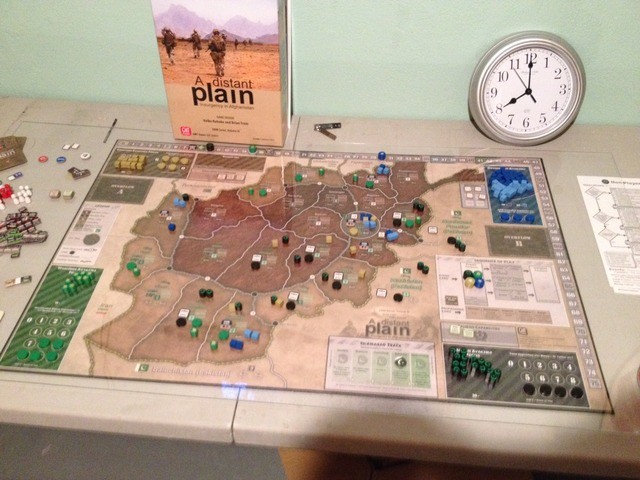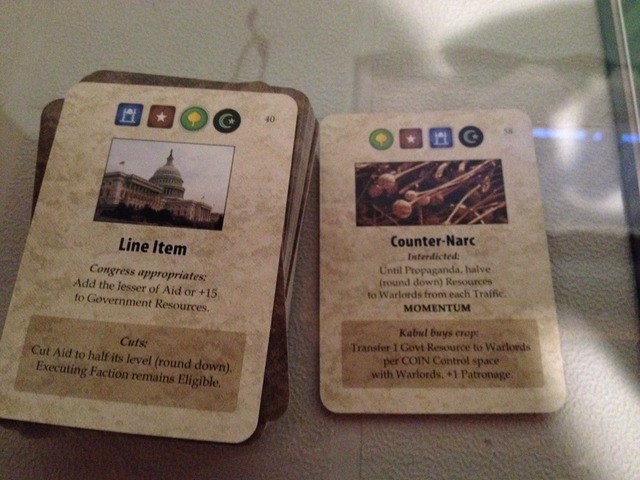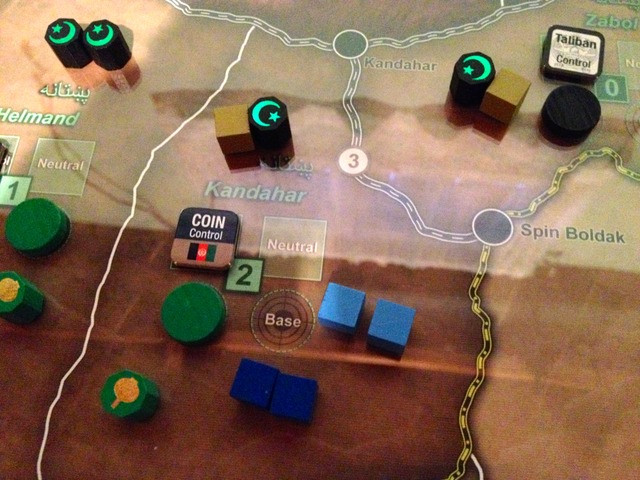I never got to deploy to Afghanistan, despite my best efforts, but at least I get to go there now, sort of. I’m just coming to grips with A Distant Plain (ADP), part of GMT’s COIN (Counter Insurgency) series of simulations. I say simulation deliberately, because it appears to me that the designers, Brian Train and Volko Ruhnkehave thought long and hard about making this a model of the political as well as military issues of the Afghan conflict.

So first impressions. ADP doesn’t seem to be an easy game to play at first glance. There are no playing pieces with comforting NATO symbology, combat values, etc. There are a LOT of tracks on the board and information markers. There are a lot of cryptic wooden playing pieces in various colours. Fortunately, there is an excellent step by step player’s guide which has an extended tutorial that I’ve been working through very carefully and deliberately, and the more that I see and learn about it, the more that I am liking it.
ADP is a game for 1-4 players and has four sides: the Coalition (Western/NATO powers), the Afghan government, the Warlords, and the Taliban. It would be a total blast with four players, but is very suitable for solitaire play as either the Coalition or the Taliban, with decision tree charts guiding the actions of the non-player factions.
The sequence of play appears to be quite elegant. There is the inevitable deck of cards (do any wargames published these days NOT come with a deck of cards?) but instead of holding cards in their hands, the cards are turned two at a time, so all players can see the card for the current turn as well as the card for the NEXT turn. Besides special events which can be chosen by either the Coalition/Afghan (the COIN) players or by the Taliban/Warlords, the cards determine sequence of play.

As you can see from these two cards, at the top of each is a row of four symbols, each corresponding to one of the four factions, so on the right hand card, the Counter-Narc card, the Warlord player’s symbol is first on the left, so he can go first, then the Coalition player, then the Afghan gov. player, then the Taliban. The order is slightly different on the left hand, “Line Item” card, which governs the next turn. The catch is that if the Warlord player acts on the first card, there is little he can do on the second card, so basically you get to move every other turn, near as I can tell so far, which means that you have to be fairly careful in deciding when you want to play and what events you want to capitalize on.

Here’s one of the areas on the map, Kandahar Province. The tan block is a Coalition force, the Green disc is a Warlord base, the smaller green circle is a Warlord guerrilla unit, the black disc with the star and crescent is a Taliban guerrilla unit, the two light blue blocks are Afghan gov police and the two dark blue blocks are Afghan gov military. Control of a province goes to the Taliban if they have the majority of units in a province, or to the COIN forces (coalition and Afghan gov if they have a majority of units. In this photo, currently, there are 5 COIN units to 2 Warlord units to 1 Taliban unit, so the COIN side has control and can count Kandahar towards its political and resource totals. Here is a cool thing. While the Taliban wants to control provinces, so do the Warlords, but for different reasons. If the Warlord player has the majority of units in a province, neither the Taliban nor the COIN side controls it, so the Warlords have their own discrete victory conditions, and in a multiplayer game, would be the player that both sides would court, because even though the Warlord has the fewest units, he has the the potential to wreak a lot of havoc. If you think of the current crisis with the Afghan elections stalemated between two leaders, one from the Pashtun south and one from the Tajik north, you can see that the game designers have thought a lot about how the Warlords represent the non-Pashtun tribes in Afghanistan, and what a complicated business it all is.
Guerilla units can either be operating openly, in which case the symbol is shown, or they can go into hiding, in which case the cylinder is inverted to show a blank side. The COIN player has a harder time finding and eradicating hidden guerrilla units.
Hopefully next week I will have more game time in, and can report on how the game plays, but for now I wanted to give you a sense of the mechanics of what promises to be a terrific game and model of a complex war. In other board game news, I finally got my copy of the new startup magazine, Ares, which true to its old SPI namesake, ships with an SF game, in this case, one based on HG Wells War of the Worlds. It looks cute and at some point, once I get out of Afghanistan, I’ll show it to you.
More to come. Blessings to your die rolls!
MP

Pleased to see you taking on this game. I'm a big fan of the COIN series since the Colombia game, it's quite a monster but plays well, though the more human players the better imo. You'll get hours of gaming from it.
ReplyDeleteCheers,
Pete.
Hi Pete:
DeleteYou're talking about the Andean Abyss game, which I think is sadly out of print. I've heard goof things about it. GMT also has a game about Cuba and Castro in that series which looks interesting.
I think ADP will be fun once I get the hang of it.
This comment has been removed by the author.
ReplyDeleteReading your description of this game reminded me of something very vaguely similar from over 30 years ago - 1981, specifically. At that time, against quite a lot of popular opposition, the South african Rugby Football team, the Springboks, toured this country, playing several provincial games, and four (I think) 'Tests' (i.e. international matched against the New Zealand All Blacks). During the whole course of the tour, every day there was a match on (Saturday and one week day), there were protest marches somewhere in the country - especially Wellington, where I was living at the time. I know about these marches, because I was on every Saturday march and about half the weekday ones.
ReplyDeleteNow, my story concerns a table/board game someone produced about half way through the Tour. The four game players represented the Government, the Media, the Protest Movement, and the Police. Of these, three of the 'factions' tried to beef up their public support (it was some points system which represented this support, or some kind of cred, anyway - I'm going by a 30+ year memory here). These three began with zero, and tried to increase their score.
Not so the Police. They began with a considerable fund of support.cred/goodwill, 30 points, I think it was, and what ever they did they could only lose points - or try and avoid losing points.
Probably the most intriguing aspect of the game was that it was far as your 'A Distant Plain' is from a zero-sum sort of game. An action that gained you credit might well gain someone else credit as well, and it might not be who you would want it to be.
As I recall, in the only occasion I played this game, I was the Police. Now, I rather think the order of play was predetermined, and the Police went last. At any rate, the game was drawing to a close, and I, as Police, was called upon to make my move. It was quickly obvious the Police could not win. There was a choice between two actions (I forget what they were specifically). Neither hurt the Police, all right, but one added to the credit of the Press, and the other helped the Government. Whichever got the benefit, won the game. There is something about a game in which one player, with no chance of winning, gets to decide who does win. It isn't so much fun if neither option appeals! I no longer recall which side I came down in favour of. But the Police and the Protest Movement came out joint last.
Considering it was a pot boiler hastily produced, it was a very playable and enjoyable game, lasting maybe an hour or so. And it very well encapsulated the conflict, the issues and the the way in which actions and rhetoric could bring in support or alienate public goodwill. I wonder whatever happened to it.
Cheers,
Ion
Great story Ion. I was a marcher myself back then. It's interesting how we can see current and political events with fresh eyes if we've had a chance to game them. I was reading a blog post a few days back by a fellow who went to GenCon and got into some huge multiplayer political NDSM (National Security Decision Making Game) about contemporary events, where he represented his country's steel industry, and his victory conditions involved resisting sanctions and encouraging arms sales. I know these types of games are huge in political studies and government think tanks - there's a prof at McGill, Rex Brynen, who I knew vaguely in under grand, who teaches them.
DeleteIt is remarkable sometimes that, reminded of a long forgotten event or action from the distant past, one's memory grows with the thinking about it. I mentioned the Press as one of the factions in the game I mentioned in the previous comment. I was mistaken: it was the NZ Rugby Football Union, whose invitation to the SARFU triggered the whole kerfuffle. I also recall that I was still leading in that final turn, but whatever action I chose benefited the government or the NZRFU, one or the other. At the same time I lost some cred.
ReplyDeleteIt says a lot about the balance of the game, too, when I recall that maybe just two, possibly three, points separated first and last (somewhere in the 'teens'). Now that I recall the fourth faction correctly, I don't think I did finish last - rather it was the Protest Movement and the NZRFU that jointly brought up the rear. Now this might be thought ironic, when all's said and done, but I rather think the game result accurately forecast the end result of the affair. 1981 was election year, and the sitting National Government (helped by a gerrymander that added value to rural seats, allied to the popularity rugby enjoys among our horny handed tons of soil) retained the Treasury benches. The Police got (as I rather figured at the time) some training in this kind of affair that they would never otherwise have got. Rugby took a knock in popularity that was really only revived come the inaugural Rugby World Cup in 1987. Meanwhile the NZRFU's utter failure to learn squat was demonstrated by the 1985 'Cavaliers' Tour to South Africa. The South Africans regarded it as a full All Black's side, of course, and by extension New Zealand's endorsement - by and large fictional - endorsement of its apartheid regime. The 'Cavaliers' were thrashed on the field; the returning players were dropped from the All Blacks - many of them for good; and the NZRFU I think never thereafter recovered its public voice. And the protest movement, despite efforts by activists to keep it alive to deal with domestic racial issues, simply evaporated the moment the Tour ended.
Cheers,
Ion
I did a graduate course in sociology last term focusing on Social Movements, and learned that some movements can draw players from smaller groups and movements (the movement of solidarity with Latin America and against US involvement there in the 1980s in North America was one such example). Did the NZ rugby protestors go back to other apartheid groups, or did they regard the hub done once NZRFU was discredited?
DeleteIt was more a case, I think, of registering there protest in emphatic fashion for the duration of the Tour. What the thing amounted to was a clash between two strongly held points of view; the one opposing the then existing Apartheid regime in South Africa (Nelson Mandela was still a political prisoner at the time); the other enthusiastically supporting sports contacts (allegedly so the regime would be led by the example New Zealand's harmonious (yeah, right) race relations), and it was true to say that the Springboks were always the toughest opponents world wide for the All Blacks to face.
DeleteThe protest movement was very popular movement, and all sorts of people from all sorts of lives marched on motorways and streets and other public places - professional people, retired pensioners, schoolkids, factory workers, you name it. The then National Government tried to make out the marches were conducted by Rentamob, each being paid by the well-known long-term anti-apartheid movements in this country. Funny thing: I seemed to be parting with $20 from time to time towards expenses - I sure lord was never given any money for wearing out shoe leather.
No: it was a popular movement, only barely controlled by the protest organisers (not helped by more violently inclined groups like Maori gangs, or police agents provocateurs). There was some violence, but that really erupted only during the final game of the Tour, the final Test Match in Auckland. It was a miracle I think that it didn't happen to any major extent earlier.
When the Tour ended, most of us simply went back home. That was it, and everything returned more or less to normal. The schism in Kiwiland that had been exposed took a long time to heal, I think. A few years later an All Black tour of South Africa was mooted, we now had a Labour Government, which, though in fact run by ultra-right-wing NeoCons, retained enough of a left wing ethos to let the NZRFU know that any such tour would not have the backing of the Government. So an unofficial team went, and not all established All Blacks chose to go. There was a bit of moaning in pro-Rugby circles, but when it emerged that the ''Cavaliers' were being paid (it was never clear to what extent this was a true or fair accusation), a certain revulsion of feeling set in, as at that time Rugby Union was an amateur sport. At that, the Cavaliers were suspended for 2 subsequent official Internationals. Their replacements (the 'Baby All Blacks') proved so capable of dispatching their opponents, not many Cavaliers ever recovered their former place in the National side.
Sorry falling behind on my blog reading. There is a lot going on in this setup.
ReplyDeleteThanks Robert. I'm ALWAYS behind in my blog reading. I hope to have more to report on ADP in next Tuesday's post.
DeleteVery interesting situation and your review explains quite a bit. I may consider this game.
ReplyDelete